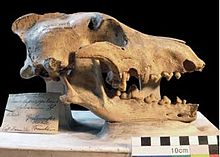| Cave wolf | |
|---|---|

| |
| The Goldfuss holotype,[1] Berlin's Natural History Museum | |
| Scientific classification | |
| Domain: | Eukaryota |
| Kingdom: | Animalia |
| Phylum: | Chordata |
| Class: | Mammalia |
| Order: | Carnivora |
| Family: | Canidae |
| Genus: | Canis |
| Species: | |
| Subspecies: | †C. l. spelaeus
|
| Trinomial name | |
| †Canis lupus spelaeus Goldfuss, 1823[2]
| |
| Synonyms[5] | |
|
C. l. brevis Kuzmina and Sablin, 1994[3] | |
The cave wolf (Canis lupus spelaeus) is an extinct glacial mammoth steppe-adapted wolf that lived during the Middle Pleistocene to the Late Pleistocene. It inhabited Europe, where its remains have been found in many caves. Its habitat included the mammoth steppe grasslands and boreal needle forests.[6] This large wolf was short-legged compared to its body size,[3] yet its leg size is comparable with that of the Arctic wolf C. l. arctos.[6] Genetic evidence suggests that Late Pleistocene European wolves shared high genetic connectivity with contemporary wolves from Siberia, with continual gene flow from Siberian wolves into European wolves over the course of the Late Pleistocene. Modern European wolves derive most of their ancestry from Siberian wolf populations that expanded into Europe during and after the Last Glacial Maximum, but retain a minor fraction of their ancestry from earlier Late Pleistocene European wolves.[7]
- ^ Cite error: The named reference
kempe2009was invoked but never defined (see the help page). - ^ Cite error: The named reference
goldfuss1823was invoked but never defined (see the help page). - ^ a b Cite error: The named reference
kuzmina1994was invoked but never defined (see the help page). - ^ Cite error: The named reference
Boudadi2012was invoked but never defined (see the help page). - ^ Cite error: The named reference
baryshnikov2009was invoked but never defined (see the help page). - ^ a b Cite error: The named reference
diedrich2022was invoked but never defined (see the help page). - ^ Bergström, Anders; Stanton, David W. G.; Taron, Ulrike H.; Frantz, Laurent; Sinding, Mikkel-Holger S.; Ersmark, Erik; Pfrengle, Saskia; Cassatt-Johnstone, Molly; Lebrasseur, Ophélie; Girdland-Flink, Linus; Fernandes, Daniel M.; Ollivier, Morgane; Speidel, Leo; Gopalakrishnan, Shyam; Westbury, Michael V. (2022-07-14). "Grey wolf genomic history reveals a dual ancestry of dogs". Nature. 607 (7918): 313–320. doi:10.1038/s41586-022-04824-9. ISSN 0028-0836. PMC 9279150. PMID 35768506.
